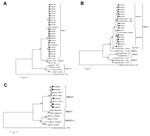Volume 19, Number 11—November 2013
Dispatch
Human Bocavirus in Children with Acute Gastroenteritis, Chile, 1985–2010
Figure

Figure. . . Phylogenetic analysis of nucleotide sequences of isolates of human bocavirus (HBoV), Chile, 1985–2010. A) Analysis of nonstructural (NS) 1 partial region of HBoV1 isolates, positions 554–792, in reference strain HBoV st1 (GenBank accession no. DQ000495). B) Analysis of NS1 partial region of HBoV2 isolates, positions 1427–1881, in reference strain HBoV2 PK225 (GenBank accession no. FJ170279). C) Analysis of nucleocapsid 1 partial region of HBoV3 isolates, positions 2256–2646, in reference strain HBoV3 IM10 (GenBank accession no. GQ867667). Isolates from Chile are indicated by black squares, and the nomenclature used includes sampling years after the dash. Phylogenetic analysis was conducted by using the neighbor-joining method. The reliability of the inferred relations was evaluated by using bootstrap test (1,000 replicates). The evolutionary distances were computed by using Kimura 2-parameter method. The reference strains (GenBank accession numbers) used for phylogenetic analysis were as follows: HBoV st1 (DQ000495), HBoV st2 (DQ000496), HBoV2 PK5510 (FJ170278), HBoV2 PK2255 (FJ170279), HBoV2 W153 (EU082213), HBoV2 UK-648 (FJ170280), HBoV3 W471 (EU918736), HBoV3 IM10 (GQ867667), HBoV3 MC8 (GQ867666), HBoV4 NI385 (FJ973561), and canine minute virus SH1 (FJ899734). Scale bars indicate evolutionary distances used to infer the phylogenetic tree.